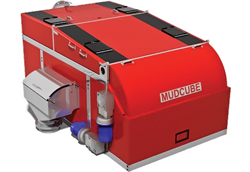ASBØRN KROKEN, Cubility AS
For more than 80 years, the technology behind the shaker has remained essentially the same. Adapted in the 1930s from the mining industry, conventional solids control equipment has always relied on gravity (g-forces) to separate shale and particles from drilling fluids. In 2004, two engineers in Norway asked themselves, “Is it possible to make a shaker that doesn’t shake?”
The two inventors at Cubility set out to answer that question. They determined that their new system would need to meet five stringent objectives to be successful:
-
Prevent any large particles from passing through damaged screens or malfunctioning equipment.
-
Minimize both the retention on cuttings and the loss of drilling fluid, while operating at maximum possible flowrates.
-
Safely remove gasses from the well and the fluid without requiring human contact with the system.
-
Measure and transmit useful fluid and equipment information to the operator.
-
Return fluid with consistent properties to the mud pits.
If they could build a system that did all this and delivered significantly higher value than the conventional shaker, it would be a true “step change” for the drilling industry. They knew that as more demanding environments were explored—deepwater, high temperature and pressure, environmentally sensitive—the industry would need a new solution. With a fresh perspective on the drilling fluid treatment process, they began work on what would eventually become known as the MudCube.
 |
| The MudCube uses an innovative vacuum conveyor separation technology for mud treatment. |
|
REVOLUTIONARY PROCESS
Designated by Statoil as proven technology in 2012, the MudCube was introduced offshore and in the Marcellus shale play. Studies show a significant improvement in safety and environmental risks during drilling operations. This smart system is made up of integrated shale conveyor technology, a vacuum system, cuttings transport and cleaning packages, real-time monitoring systems, filtration medium failure detection, touch-screen controls and automation components. It operates cleanly and safely without the high g-forces, degradation of cuttings, and fluid vapor pollution associated with traditional shakers.
The MudCube is based on vacuum conveyor separation (VCS) technology. The system applies a vacuum to pull the fluid through a slowly revolving screen. As the fluid is vacuumed through the screen and support belt, an air knife dries the cuttings and pushes effluent back into the active vacuum system. A second air knife removes residual solids from the screen and deposits them in the discharge line.
Cuttings are discharged over the end of the screen belt and can be handled in traditional ways, or the vacuum system can be utilized in a cuttings transport system. After passing through the secondary filtration system, the clean fluid is separated from air and gases in a negative pressure vessel. The air and gas are pulled through the negative pressure generating unit and the cyclone filter on the unit is used to capture effluent, water mist, or oil mist in the vent, which are returned to the active system.
REAPING THE BENEFITS
By supplementing, or replacing, conventional solids control equipment at the rig site, the MudCube can provide substantial savings during initial rig builds, as well as significant footprint savings on many rigs already operating. The MudCube requires less equipment overall (eliminating the requirement for a separate gas separator) and fewer personnel for operation, due to its simplified and flexible system configurations. Reduced mud loss, lower weight and lower power consumption also contribute to considerable savings.
As stringent environmental regulations are enacted at drill sites, the MudCube provides a more environmentally safe approach to mud treatment. Because the filtrating process is kept inside the “cube,” the fumes and gases ordinarily released with traditional shaker systems are kept enclosed, eliminating the risk of exposing personnel to harmful emissions. Additionally, with MudCube’s real-time visual monitoring of cuttings, workers are able to safely monitor drilling fluid parameters, fluctuations in mud weight, and detect harmful gases immediately, allowing for rapid response to changing well conditions and damaged screens.
As drilling environments become more complex and the industry increases its reliance on unconventional resources, the MudCube is changing the way drilling contractors utilize smart mud treatment systems.
FIELD TESTING
Cubility built a full-scale test-center in two phases in 2007–2008, situated next to the company’s head office in Stavanger. The facility can simulate offshore mud handling in a full loop.
In 2008, Cubility received the Spotlight on New Technology award at the Offshore Technology Conference in Houston and the Innovation Award for small and medium-sized enterprises (SMEs) at the Offshore Northern Seas Conference in Stavanger.
Test equipment was installed at Oseberg B platform on the Norwegian continental shelf in April 2009 and put through an extensive test program through 2009 and 2010. Statoil finalized the offshore pilot tests of the MudCube in late April 2010. In March 2011, Statoil announced that the MudCube technology had been approved for Statoil’s operations.
Cubility CEO Jan Thore Eia said, “When Statoil as leading operator on the Norwegian Continental shelf and increasing international activity find us qualified for their operations, this is extremely good news.” 
|



